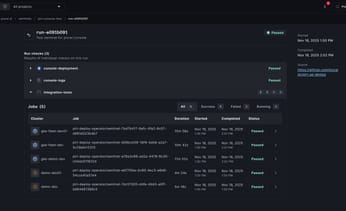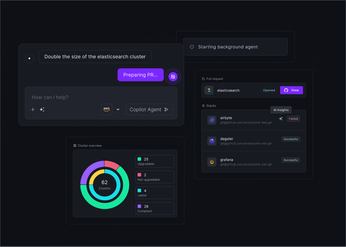
5 Best Kubernetes Single Pane of Glass Tools for 2025
Find the best Kubernetes single pane of glass tool for unified cluster management, security, and observability across cloud, on-prem, and edge environments.
Every day, engineering teams lose hours to context-switching—moving between terminals, cloud consoles, and observability tools just to trace a single issue. Each switch interrupts focus and slows down incident resolution, turning what should be a fast debugging session into an extended, fragmented process.
This inefficiency compounds over time. Instead of building new features or improving system reliability, skilled engineers are stuck navigating scattered dashboards and inconsistent interfaces.
A Kubernetes “single pane of glass” solves this by consolidating monitoring, deployment, and control into one cohesive platform. It minimizes repetitive manual steps and unifies visibility, allowing teams to diagnose and act faster.
This guide outlines a structured approach to evaluating these platforms, helping you identify the best Kubernetes single pane of glass solution to reduce operational overhead and refocus your engineering efforts on meaningful work.
Unified Cloud Orchestration for Kubernetes
Manage Kubernetes at scale through a single, enterprise-ready platform.
Key takeaways:
- Focus on integrated workflows, not just a dashboard: A true management platform unifies core operational concerns like GitOps deployment, infrastructure-as-code (IaC), and security into a single, API-driven workflow. This integration is more valuable than a simple aggregated view, as it creates a consistent and reliable process for managing your entire fleet.
- Adopt an architecture built for secure, multi-network management: Your platform's architecture must securely manage clusters across diverse environments. An agent-based, egress-only communication model provides full visibility and control over clusters in private VPCs or on-prem data centers without exposing internal endpoints or requiring complex network configurations.
- Enforce fleet-wide standards with policy-as-code: Use your management platform to centralize control and eliminate configuration drift. By defining security policies and RBAC rules in a central Git repository and using the platform to sync them across all clusters, you can ensure consistent compliance and security posture at scale.
What Is a Kubernetes “Single Pane of Glass”?
A Kubernetes “single pane of glass” is a centralized management console that provides unified visibility and control across your entire cluster fleet. Instead of switching between multiple dashboards, terminals, and cloud consoles, teams can operate everything from one interface. As organizations expand across cloud, on-prem, and edge environments, this approach becomes essential for maintaining consistency and operational efficiency.
It simplifies the complexity of distributed systems by creating a consistent management layer that abstracts infrastructure differences. The goal is to give platform teams a single source of truth for observing system health, deploying applications, and enforcing policies across environments. For example, rather than manually patching dozens of clusters, teams can apply updates once from a central dashboard.
Plural delivers this capability through a unified management console that securely connects to clusters wherever they run—cloud or on-prem. This enables teams to manage deployments, troubleshoot issues, and monitor infrastructure in one place, transforming fragmented systems into an integrated operational experience.
Why a Unified View Matters
Managing distributed Kubernetes environments without a unified view forces constant context-switching between tools and interfaces, slowing down response times and increasing the risk of drift and misconfiguration. A single pane of glass eliminates this friction by consolidating observability and control, improving both efficiency and security.
Plural’s agent-based architecture makes this possible through a secure, egress-only communication model. Each managed cluster reports back to the central console, providing deep visibility—even for clusters running in private VPCs or local setups—without requiring complex VPNs or network exposure. The result is a single operational view that enhances collaboration and accelerates issue resolution.
Clearing Up Common Misconceptions
“Single pane of glass” is often misinterpreted as a promise of one tool to replace every specialized system. In practice, it’s not about building a monolith—it’s about creating a unified control plane that integrates core workflows across the Kubernetes ecosystem.
A true single pane of glass acts as a hub for managing critical functions such as CI/CD, Infrastructure as Code (IaC), and observability. Plural achieves this by tying together GitOps-driven deployments with Terraform management in a Kubernetes-native framework. The real advantage lies in having one consistent, API-driven workflow—not one oversized tool.
Core Benefits for DevOps and Platform Teams
For DevOps and platform teams, a single pane of glass translates directly into reduced operational overhead. Routine maintenance, configuration, and troubleshooting become faster and more predictable. Engineers spend less time firefighting and more time delivering new capabilities.
It also strengthens governance and collaboration. With shared visibility and uniform controls, teams can enforce security policies, manage access, and ensure compliance more effectively. Using Plural, platform teams can even build self-service infrastructure catalogs, empowering developers to deploy resources confidently with built-in guardrails.
Ultimately, a Kubernetes single pane of glass gives teams unified control, consistent workflows, and the confidence to manage infrastructure at scale without sacrificing velocity or reliability.
Key Features of a Kubernetes Management Platform
A true “single pane of glass” for Kubernetes goes far beyond a visual dashboard. It’s a unified management platform that consolidates the critical workflows DevOps and platform teams depend on—visibility, security, automation, and observability. The difference between a static UI and a real management platform lies in actionability: the ability not just to observe, but to operate your clusters securely and efficiently.
An effective solution provides end-to-end integration across your environments, enforces consistency through GitOps, and enables teams to act on insights directly within the same interface.
Multi-Cluster Visibility and Control
Operating clusters across clouds, on-prem data centers, and edge locations often leads to fragmented views and disconnected workflows. A robust management platform consolidates these perspectives, offering real-time visibility into cluster health, workloads, and resource utilization across your entire fleet.
This capability should go beyond passive monitoring. Teams need the ability to securely execute ad-hoc operations when diagnosing issues. Plural achieves this with a secure reverse tunneling proxy that enables direct access to resources in private environments—without exposing endpoints or requiring VPNs. From a single console, you can inspect, troubleshoot, and manage clusters whether they’re running in production or local development.
Centralized Security and Access Management
Security inconsistency across clusters is one of the biggest operational risks in Kubernetes environments. A centralized platform mitigates this by standardizing identity and access management. Integration with your organization’s SSO and enforcement of Kubernetes-native RBAC ensure a unified security posture.
Plural strengthens this with Kubernetes Impersonation, mapping dashboard actions directly to SSO user identities. Using features like Global Services, you can define RBAC policies once in Git and automatically propagate them across clusters—ensuring the right users always have the right permissions everywhere.
Resource Optimization and Cost Management
Fragmented visibility makes it difficult to identify underused resources or attribute spending accurately. A unified control plane centralizes resource data across clusters (covering CPU, memory, and storage consumption) so teams can detect inefficiencies and enforce quotas.
This aggregated insight forms the foundation of intelligent cost management. By correlating resource usage with workloads and teams, platform engineers can make data-driven decisions on scaling, workload placement, and capacity planning. Over time, this drives a culture of accountability and cost-awareness throughout the organization.
Native GitOps Integration
GitOps is the operational backbone of modern Kubernetes management. A capable platform must natively integrate with Git to serve as the source of truth for both application and infrastructure configuration.
Plural’s Continuous Deployment and Stacks systems are built on this principle. Using an agent-based pull model, they automatically detect Git commits, synchronize manifests and Terraform configurations, and report deployment results back to pull requests. Every change is declarative, version-controlled, and auditable, ensuring consistent, reproducible operations across environments.
Built-in Monitoring and Observability
Visibility into application health is critical for reliable operations. Jumping between deployment tools and separate observability stacks wastes time and obscures root causes. A single pane of glass integrates these systems, allowing teams to correlate deployment events with metrics, logs, and traces in one place.
Plural simplifies this by providing centralized deployment and management of observability tools such as Prometheus and Elasticsearch. These can be provisioned directly from its application catalog, giving teams a fully integrated monitoring stack managed with the same GitOps principles as the rest of their infrastructure.
In short, a Kubernetes management platform earns the title of “single pane of glass” when it unifies visibility, control, and automation—turning operational complexity into a cohesive, secure, and data-driven workflow.
A Look at the Top Kubernetes Management Platforms
Selecting the right Kubernetes management platform directly impacts how efficiently your team operates, how securely you manage workloads, and how easily you can scale. Each platform takes a distinct approach to simplifying multi-cluster operations. Some, like Red Hat OpenShift, bundle everything into an all-in-one enterprise suite, offering tight integration but introducing potential vendor lock-in. Others, like Rancher, emphasize flexibility—supporting any certified Kubernetes distribution through a universal control plane.
The right choice depends on your existing infrastructure, security requirements, and operational philosophy. Platforms like VMware Tanzu are ideal for VMware-heavy environments, while Plural is built to thrive in diverse, multi-cloud setups with a secure, agent-based model. The following overview highlights five leading platforms, their core strengths, and the use cases where they excel.
Plural
Plural delivers a unified management experience for Kubernetes fleets using a GitOps-first architecture. Its secure, agent-based pull model means clusters never need to expose endpoints—communication flows outward from each cluster to the control plane, maintaining strong security boundaries.
Plural’s platform combines four core capabilities:
- Continuous Deployment for Kubernetes with declarative GitOps workflows.
- A secure, SSO-enabled dashboard for live troubleshooting and visibility.
- API-driven IaC integration for Terraform-based provisioning.
- A self-service catalog that generates and manages application manifests.
This architecture provides consistent control and automation across public clouds, private data centers, and local environments, making it an ideal fit for teams that prioritize security, autonomy, and scalability.
Rancher
Rancher, developed by SUSE, is known for its simplicity and strong multi-cluster management capabilities. It provides a centralized control plane that works across on-prem, cloud, and edge deployments without locking users into any specific Kubernetes distribution.
Its straightforward UI and consistent tooling make it particularly appealing to teams adopting multi-cluster operations for the first time. Rancher includes unified provisioning, centralized policy management, and integrated security controls, allowing organizations to standardize operations across heterogeneous environments while keeping management overhead low.
VMware Tanzu
VMware Tanzu is a modular suite tailored for enterprises deeply invested in the VMware ecosystem. It integrates seamlessly with vSphere, enabling teams to manage both virtual machines and Kubernetes clusters from a single interface.
Tanzu’s strength lies in bridging traditional and cloud-native workloads, helping organizations modernize applications without completely overhauling existing infrastructure. It’s well-suited for large enterprises seeking consistent governance, enterprise security, and a gradual path toward containerization—all within a familiar VMware operational model.
Red Hat OpenShift
Red Hat OpenShift offers one of the most complete enterprise Kubernetes solutions on the market. It packages Kubernetes with an integrated toolchain for CI/CD, service mesh, serverless, and security policy enforcement, delivering an opinionated but highly capable platform.
OpenShift’s focus on security, compliance, and lifecycle automation makes it a strong choice for regulated industries and large organizations that prefer a turnkey solution. Its all-in-one design accelerates development workflows while maintaining consistent governance across hybrid and multi-cloud environments.
Google Anthos
Google Anthos extends Google Kubernetes Engine (GKE) to on-prem and multi-cloud environments, enabling consistent management and operations across Google Cloud, AWS, Azure, and on-prem data centers.
Anthos provides a unified control plane for policy enforcement, service management, and security, leveraging Google Cloud’s ecosystem of tools. Its hybrid design allows enterprises to modernize existing applications while maintaining operational consistency across environments. For teams already leveraging GKE or migrating to a multi-cloud model, Anthos delivers strong integration and scalability without losing Kubernetes-native flexibility.
In summary, while each of these platforms solves Kubernetes complexity in its own way, Plural distinguishes itself with its agent-based, GitOps-driven design—providing secure, scalable management for heterogeneous environments without vendor constraints.
How to Choose the Right Platform for Your Team
Choosing a Kubernetes management platform is a strategic decision that influences your team’s operational efficiency, security posture, and long-term scalability. The right solution unifies workflows and reduces complexity; the wrong one adds friction and technical debt. Rather than chasing an all-in-one promise, focus on finding a platform that aligns with your current infrastructure, engineering culture, and growth trajectory. Evaluating key technical and organizational factors will help ensure your choice becomes an accelerator—not another layer of overhead.
Assess Your Technical Requirements
Kubernetes is inherently powerful but complex—often requiring expertise with YAML, kubectl, and intricate resource configurations. A good management platform should help your team navigate this complexity without limiting flexibility. Consider the mix of skills within your team: do you need a visual, GUI-driven interface for faster onboarding, or a system that enhances API-driven automation for advanced users?
The best solutions combine both. For example, Plural provides an embedded Kubernetes dashboard for interactive troubleshooting while maintaining a fully API-driven, GitOps-based backend for automation. This hybrid approach ensures every team member—from operators to developers—can work in their preferred mode without breaking consistency.
Evaluate Integration Capabilities
Your Kubernetes platform should integrate seamlessly into your existing DevOps toolchain. Assess compatibility with your Git providers (GitHub, GitLab), CI/CD systems, identity management (SSO, OIDC), and observability stack. A unified view should not come at the expense of vendor lock-in or closed ecosystems.
Look for open APIs, custom resource definitions (CRDs), and native GitOps integration. Plural’s architecture is built around these principles—it natively connects to your Git repositories, uses OIDC for authentication, and allows external systems to interact through a CRD-based interface. This ensures it enhances your stack rather than replacing it.
Analyze Your Security Needs
Security is one of the hardest challenges in multi-cluster Kubernetes management. A strong platform should provide a consistent, enforceable security model across every cluster and environment. Prioritize features such as:
- Fine-grained Role-Based Access Control (RBAC)
- SSO integration with your identity provider
- Audit logging for traceability
Plural handles this through Kubernetes Impersonation, mapping user actions directly to their authenticated identity. This provides a secure SSO experience while ensuring proper RBAC enforcement. With its Global Services feature, Plural allows you to define and synchronize security policies and RBAC rules across all clusters—eliminating drift and simplifying compliance.
Create a Cost Analysis Framework
The total cost of ownership for a Kubernetes platform goes far beyond licensing. Include the operational effort, training requirements, and potential downtime in your analysis. Platforms with strong visibility and automation can offset their costs by improving resource utilization and reducing manual work.
Plural’s unified dashboard surfaces metrics from all clusters, enabling teams to identify underused resources and prevent performance bottlenecks. Its automation capabilities reduce the engineering time required for maintenance, freeing up teams to focus on higher-value work.
Plan for Future Scalability
Kubernetes adoption often starts small but scales rapidly. Your management platform should grow with you—handling more clusters, workloads, and users without compromising performance. Architecturally, agent-based pull models tend to scale better than centralized push systems, since they distribute operational load and minimize network exposure.
Plural embodies this scalable approach through its agent-based design, enabling it to manage clusters securely across clouds, data centers, and edge environments. As your infrastructure expands, it maintains consistent performance and control, ensuring long-term reliability without rearchitecture.
By aligning your choice with these principles—technical fit, integration, security, cost efficiency, and scalability—you’ll identify a Kubernetes management platform that not only meets today’s needs but positions your team for sustainable growth.
Implementing Your Platform: A Practical Guide
Choosing the right Kubernetes management platform is only the beginning—the true value comes from how you implement it. A well-executed rollout ensures that the platform integrates seamlessly into existing workflows, strengthens security, and enhances performance. Without a deliberate implementation strategy, even the most capable platform can become a new source of operational complexity. Many teams fall into this trap by rushing deployment or overlooking how the change affects developer workflows.
The goal is to build a secure, stable, and efficient foundation for managing your Kubernetes fleet at scale. This goes beyond software installation—it involves defining processes, enforcing consistent security from day one, and enabling teams to confidently use the new system. A successful implementation transforms the platform into an invisible layer of support, allowing engineers to focus on delivering features rather than managing infrastructure. The following framework outlines the essential steps for turning your chosen platform into a lasting operational advantage.
Define Your Deployment Strategy
Start by deciding how your platform will be deployed and managed. Will you use a centralized management plane for unified control, or distribute capabilities across teams for more flexibility? This architectural choice affects how policies are enforced and how developers interact with infrastructure.
Plural uses a centralized, agent-based pull model. A management cluster acts as the control plane, while lightweight agents run on each target cluster. This setup allows management of clusters across cloud, on-premises, and edge environments without requiring direct network access. Since all communication originates from the agents, you maintain a secure, egress-only configuration—eliminating the need for VPNs or complex firewall rules while preserving both centralized visibility and decentralized execution.
Configure Security from Day One
Security must be foundational, not reactive. A Kubernetes management platform should deliver end-to-end visibility of your security posture through a unified interface. This begins with standardized access control across all clusters. Managing access manually at the cluster level is error-prone and unscalable.
Plural integrates directly with your existing OIDC provider, providing a consistent SSO experience for Kubernetes access. Using standard RBAC, you can define roles and bindings based on user identities or group memberships. With Plural’s Global Services, you can synchronize RBAC manifests across all clusters, ensuring uniform enforcement of policies. This consistency reduces the risk of configuration drift and simplifies compliance audits.
Optimize for Performance
Performance optimization depends on real-time visibility across your infrastructure. A unified monitoring dashboard streamlines troubleshooting, resource management, and capacity planning. Without this, teams waste time correlating fragmented data from separate observability tools, slowing response times and obscuring systemic issues.
Plural’s multi-cluster dashboard provides a live overview of workloads, networking, and storage across your entire fleet. Engineers can instantly identify performance bottlenecks or failing resources, enabling proactive maintenance and efficient scaling decisions. The result is smoother application performance and reduced time to resolution.
Drive Team Adoption and Training
The best platform is ineffective if teams don’t use it. Adoption depends on reducing friction and demonstrating value. By simplifying Kubernetes operations and consolidating multiple tools into one interface, platform teams can make new workflows intuitive rather than disruptive.
Plural’s Self-Service Catalog empowers developers to deploy pre-approved infrastructure components while ensuring compliance with organizational standards. This approach preserves agility without sacrificing control. Pair this with structured onboarding, documentation, and hands-on training to reinforce best practices. Once engineers experience faster deployment cycles and fewer manual steps, adoption follows naturally—turning the platform into a cornerstone of everyday development.
Exploring Advanced Management Capabilities
Modern Kubernetes management platforms are evolving beyond basic visibility and control. They now enable organizations to operate proactively—anticipating issues, enforcing governance, and optimizing resource usage automatically. This evolution transforms the “single pane of glass” from a static dashboard into an intelligent control plane that actively enhances operational efficiency and security. The following advanced capabilities distinguish simple aggregators from true enterprise-grade fleet management solutions.
AI-Powered Operations
At scale, Kubernetes generates massive volumes of telemetry data—logs, metrics, and traces—that can easily overwhelm human operators. AI-powered operations (AIOps) address this challenge by applying machine learning to analyze these data streams in real time. Instead of static alert thresholds, AIOps models detect nuanced behavioral patterns and anomalies that indicate emerging problems.
For example, an AI-driven system can correlate a gradual memory leak across multiple pods with a recent code deployment, surfacing the root cause before it leads to an outage. This intelligence turns reactive firefighting into proactive system health management, providing a single, contextualized view for faster and more accurate debugging.
Automated Troubleshooting
Diagnosing issues in distributed systems typically requires context-switching between multiple dashboards, terminals, and monitoring tools. A unified platform eliminates this friction. When alerts fire, engineers can access complete operational context within seconds—no manual correlation required.
Plural’s multi-cluster dashboard enables this by presenting a holistic view of workloads and infrastructure across all clusters. Engineers can drill down from a global health summary to individual pod logs or metrics instantly. Thanks to Plural’s agent-based pull architecture, you can troubleshoot clusters inside private networks securely, without configuring VPNs or maintaining complex network routes.
Centralized Policy Management
As organizations scale, maintaining consistent policies across teams and clusters becomes increasingly difficult. Divergent configurations and tooling often lead to security drift and compliance risks. A unified management platform solves this through policy-as-code.
With Plural, platform teams can define security baselines, network rules, and resource limits in a central Git repository. Using Global Services, these policies are automatically applied across every managed cluster, ensuring uniform governance without manual intervention. This model enforces compliance and best practices by default while preserving team autonomy.
Fleet-Wide Resource Governance
Efficient resource governance balances performance, cost, and scalability. A comprehensive Kubernetes management platform provides fleet-wide visibility into compute, storage, and networking utilization across clouds and on-prem environments. This insight enables cost control and capacity planning through metrics-driven decisions.
Plural extends this capability with its Stacks feature, allowing teams to manage infrastructure as code. Standardizing how clusters and applications are provisioned ensures that every environment adheres to the same governance rules. Combined with centralized monitoring, this approach delivers consistent efficiency and financial accountability across your entire Kubernetes footprint.
Related Articles
Unified Cloud Orchestration for Kubernetes
Manage Kubernetes at scale through a single, enterprise-ready platform.
Frequently Asked Questions
What's the difference between a Kubernetes dashboard and a "single pane of glass" platform? A standard Kubernetes dashboard typically provides a UI for viewing and interacting with resources within a single cluster. A "single pane of glass" platform is a comprehensive management layer that unifies the core operational workflows—like deployment, infrastructure management, and security—across your entire fleet of clusters. It's less about just viewing pods and more about providing a consistent, API-driven control plane to manage distributed infrastructure reliably and at scale.
How does a platform like Plural securely manage clusters in private networks without a VPN? Plural uses a secure, agent-based pull architecture. A lightweight agent installed on each managed cluster initiates an egress-only connection back to the central management plane. This reverse tunneling proxy allows the central console to communicate with the cluster agent without requiring you to expose internal cluster endpoints or manage complex VPNs and firewall rules. All operations are executed by the agent using local credentials, ensuring a secure and scalable way to manage clusters regardless of their network location.
Does adopting a unified platform mean I have to abandon my existing tools like Terraform? Not at all. An effective management platform should integrate with your existing toolchain, not force you to replace it. The goal is to provide a consistent workflow for managing different tools. For example, Plural Stacks is a Kubernetes-native framework that treats infrastructure-as-code, like Terraform, as a first-class citizen. It automates Terraform runs based on Git commits and provides visibility into plans and state directly within the platform, unifying your application and infrastructure management without requiring you to change your core tools.
How does a single pane of glass help enforce consistent security policies, like RBAC, across dozens of clusters? Managing policies manually across many clusters inevitably leads to configuration drift and security gaps. A unified platform solves this by enabling policy-as-code. With Plural, you can define your fleet-wide RBAC rules in a single Git repository. Using the Global Services feature, you can then create a rule that automatically syncs these manifests to every cluster you manage. This ensures that every cluster has the exact same permissions and security posture, enforced automatically and tracked in Git.
Is a "single pane of glass" just for viewing resources, or can it help with automation and deployment? While visibility is a key benefit, a true management platform is fundamentally about automation. Its primary function is to provide a unified control plane for your deployment and management workflows. For instance, Plural is built around a native GitOps engine that automates the deployment of both applications and infrastructure. It treats Git as the single source of truth, automatically detecting changes and applying them to the correct clusters, which brings consistency, auditability, and reliability to your entire operational lifecycle.
Newsletter
Join the newsletter to receive the latest updates in your inbox.







